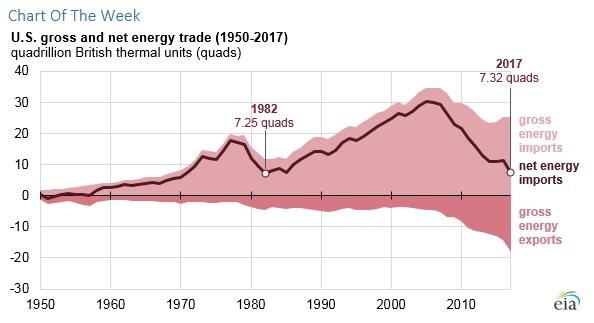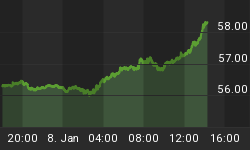Monday, April 2, 2018
China slaps tariffs on U.S. goods. China retaliated against the U.S., announcing tariffs on $3 billion worth of food imports on Monday. The tariffs, which range from 15 to 25 percent, will hit 120 different U.S food products, including fresh fruits, almonds, pistachios, pork, wine and more. The levies are effective beginning on Monday. Still, because China avoided tariffs on major exports, such as soybeans or aircraft, analysts believe it demonstrates a desire to avoid a much more serious trade war. Declining to target some of the most important products leaves room for negotiations and perhaps de-escalation.

(Click to enlarge)
- Total net energy imports into the U.S. fell by a staggering 35 percent in 2017 from a year earlier. Energy imports stood at 7.3 quadrillion BTU, the lowest level since 1982.
- The decline is largely the result of a surge in energy exports, both LNG and crude oil. Gross U.S. energy exports jumped by 27 percent in 2017.
- Higher crude oil production also cut out the need for some imports.
- The U.S. became a net exporter of petroleum products in 2011 (mostly refined fuels) and natural gas in 2017.
Markets
Record start to M&A, but more risks. Global deal-making is off to a record start this year, according to the WSJ, although the blitz of activity could be put at risk if a trade war continues to escalate. Over $1 trillion in deals around the world have been announced so far in 2018, but the risk involved in some of those deals is on the rise because of unpredictability in Washington. “We don’t like big deals. With U.S. protectionism, it’s become more and more difficult to assess if we’ll get approval,” Catherine Berjal, CEO of hedge-fund firm CIAM, told the WSJ. “Anything that’s going to touch on international firms in Asia or the Middle East looking to acquire or merge with U.S. firms is going to get a bit of pushback,” Sam LaNasa, director of business advisory services at Citigroup, said in a WSJ interview. Related: Warren Buffett Secures $125B In Real Estate Deals
Rising interest rates imperils U.S. consumers. The U.S. economy is performing well, but that also means that the Federal Reserve has room to hike interest rates. That endangers U.S. consumers who are loading up on debt. Credit card delinquencies are on the rise and U.S. consumer debt expanded at the fastest rate in the fourth quarter in over a decade, Bloomberg reports. And unlike the financial crisis in 2008, which centered on mortgage debt, student loans and auto debt has exploded in recent years.
Only 14 percent of jobs “highly automatable.” A report from two Oxford academics concludes that only about 14 percent of jobs in OECD countries are “highly automatable,” which could result in “further polarisation of the labour market,” but not the “massive technological unemployment” that many have long feared. The report is notable because the same authors published a report in 2013 predicting that as much as 47 percent of U.S. jobs were at risk of automation.
Commodities
Steel and aluminum battle for auto market. The rise of electric vehicles was thought to lead to a large-scale switchover from steel to light-weight aluminum, which would aid in extending the range of EVs. But steel is making somewhat of a comeback, according to Reuters, due to its lower cost. Aluminum on the London Metal Exchange costs more than $2,000 per ton, while steel rebar costs less than $600 per ton. Still, aluminum demand for EVs and hybrid vehicles is set to increase ten-fold to almost 10 million tonnes by 2030.
Gold gains on trade war concerns. Gold posted gains after China announced retaliatory trade tariffs against U.S. products, as investors flocked to safety. Spot gold prices rose by 0.5 percent in early trading on Monday. "The trade war is going on and it is getting worse, so that might be the reason that people are selling dollar and buying gold," said Yuichi Ikemizu at ICBC Standard Bank, according to Reuters.
Commodities a contrarian investment play. Commodities have been hit hard over fears of a trade war. Copper fell by 4 percent in March, for instance. However, if the fears subside and the U.S. and China ratchet down tensions, commodities could be a big opportunity for investors. The U.S. and China are reportedly negotiating behind the scenes even as they announced tariffs. Global trade remains strong and commodity prices are trading at discounts, offering entry points. Meanwhile, if trade disputes hurt Chinese exports, that increases the odds of further economic stimulus measures from Beijing, which would bolster commodity prices.
Energy
Brent briefly breaks $70 on falling U.S. rig count. The U.S. rig count fell by 7 last week, a surprise drop off that led to sense of bullishness in the oil market. “The market is set for a re-test of the highs of 2018,” Olivier Jakob, oil analyst at Petromatrix, told Reuters. Meanwhile, the deadline for the U.S. to recertify the Iran nuclear deal and issue a waiver for sanctions comes due in May, and most analysts expect the U.S. to begin the process of re-imposing sanctions on Iran, which puts a significant volume of oil supply at risk. “The Iranian factor is going to be a very significant input for the next four weeks. It is going to be an underlying support for the whole month,” Jakob said. Oil prices fell back on Monday morning, but the upside potential remains.
Investment banks raise oil price forecast. A Wall Street Journal survey of 15 investment banks predicts a rise in oil prices. The average price forecast for Brent for 2018 now stands at $63 per barrel, with WTI at $59 per barrel. Both price forecasts are $1 per barrel higher than last month’s forecast. The bullish trajectory can be attributed to the decline in crude oil inventories around the world combined with an uptick in fears of geopolitical conflict, particularly between the U.S. and Iran. Related: Gold Investors Shouldn’t Expect A Replay Of 2008
Russian oil production hits 11-month high. Russia’s oil output rose to 10.97 million barrels per day in March, according to government data, an 11-month high. That level of output is also significant because it exceeds the limit that Russia agreed to as part of the OPEC/non-OPEC deal. It is also the first increase in production since December. Meanwhile, Saudi Arabia and Russia are in discussions on how to formalize their cooperation beyond the expiry of the current output agreement.
Cryptocurrencies
A cap on Ethereum supply? Vitalik Buterin, the founder of Ethereum, has proposed limiting the supply of the cryptocurrency to 120,204,432, or “exactly 2x the amount of ether” that was originally sold in 2014. In an Ethereum improvement proposal (EIP), Buterin is hoping to satisfy critics who argue the lack of clarity on the matter deters investors. Unlike Bitcoin, which has a stated maximum limit, Ethereum has been open-ended. Buterin said the proposal would “ensure the economic sustainability” of the cryptocurrency.
Market cap of cryptocurrency market plunges in Q1. The first quarter of 2018 was an abysmal one for cryptocurrencies, which saw a collective market cap for the entire sector decline by 59 percent. The cryptocurrency market cap has plunged to about $250 billion, down from $610 billion at the start of the year. Bitcoin lost half its value, with prices currently sitting at about $7,000. Some smaller cryptocurrencies fared worse, some losing over 70 percent of their value since January.
Regulation fears hitting cryptocurrencies. Two cryptocurrency exchange startups withdrew their applications in Japan after financial regulators demanded stricter security features. The move comes after a $500 million theft occurred on Coincheck, a cryptocurrency exchange. Also, a month ago, Bank of England Governor Mark Carney said that cryptocurrencies are “failing” and called for a global crackdown. Fears of regulation are mounting, and they are taking a toll on the crypto market.
By Charles Benavidez for Safehaven.com
More Top Reads From Safehaven.com:

















